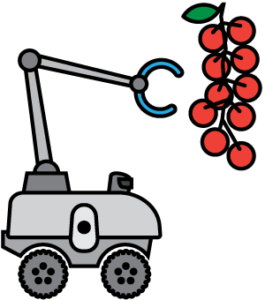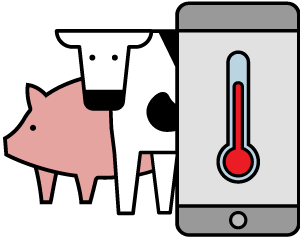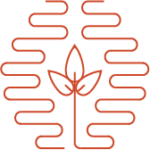Research
The research activities in AIFARMS are organized in four AI + Agriculture thrusts and a cross-cutting Technology Adoption thrust. Each of the research thrusts address an important societal need. These thrusts are formulated in terms of broad agricultural goals (both research and production), and the concrete AI challenges that must be solved to achieve these goals. In order to achieve specific agriculture outcomes that require specific “use-inspired” AI advances, the research projects in each thrust will be designed and tested via the iterative research strategy.

Thrust 1: Autonomous Farming
Hypothesis: Teams of small, inexpensive, and intelligent robots (agbots) can alleviate the agricultural labor crisis, encourage sustainable crop management practices, and enhance farm profitability.
We will design, develop, evaluate, and refine an AI-driven farm in collaboration with project partners. This highly automated and deeply instrumented farm, complete with sensor networks, agbots, edge ML hardware, and edge-cloud connectivity, will enable innovative research and evaluation of our AI-driven technologies and serve as a prototype of our vision for the future of production farming by 2030. The farm will be made available to external users from all NSF AI Research Institutes, other researchers, and industry.
Autonomous Farming Goals
- Low-cost agbots for under the crop canopy
- Agbot harvesting, weeding, and sampling
- Scouting and management of fields
- Intuitive agbots and decision support

Thrust 2: Labor Optimization for Livestock
Hypothesis: Advanced computer vision algorithms and machine learning can be used to monitor livestock health and behavior and human-animal interactions, enabling small teams of skilled managers to achieve better outcomes in animal health and welfare with reduced labor requirements.
The goal of this Thrust is to develop tools to monitor, evaluate, and recommend actions to simplify day-to-day caretaker activity and to enable less experienced staff to handle production livestock while improving animal welfare and environmental impact. We will focus on pig production, but the tools will be cross-cutting to other animal production sectors.
Labor Efficiency in Livestock Goals
- Estimating/predicting animal physical and mental health
- Managing with human caretakers who are limited in numbers and skills
- Rapid detection of anomalous conditions

Thrust 3: Environmental Resilience
Hypothesis: New AI techniques for predictions from heterogeneous data across widely varying scales, and new learning techniques from limited labeled data, can enable crop genetic improvement for increased resilience to environmental variability, provide improved utilization and management of water and nitrogen, and mitigate nitrogen runoff.
Environmental Resilience Goals
- Phenotyping and environment monitoring from partially-labeled data
- Accurate phenotypes and scaling from plots to fields to regions
- Efficient phenotypic and environmental monitoring

Thrust 4: Soil Health
Hypothesis: Quantifying, predicting, and managing soil nutrient fluxes through an agricultural field system can significantly benefit from a domain science informed AI predictive framework for addressing limited and heterogeneous data.
Identifying, predicting and managing when and why nutrients enter, are transformed, and leave agro-ecosystems is necessary for a comprehensive system understanding for the next generation of precision agriculture and precision conservation, but is constrained by: (1) Small and disparate datasets insufficient to monitor interactions that span spatiotemporal scales, and (2) Integrating and modeling soil data across nested spatial and temporal scales. An AI-based approach to soil and nutrient management that quantifies field-scale inputs and outputs of nutrients and water across micro-, meso-, and macro-scales can be used to comprehensively manage internal (e.g., yield) and external (e.g., environmental quality) consequences of nutrients for sustainable resource use, farmer profitability, and social welfare.
Soil Health Goals
- Quantifying, predicting, and managing soil nutrient and moisture fluxes
- Integrating varied data types across scales, from furrow to field, from weeks to years
- High variability across spatial-temporal scales, and impact on short- and long-term system outcomes

Cross-Cut Thrust: Technology Adoption
Hypothesis: Economic factors may influence farmer technology adoption decisions, including the capital and skill-intensity of these technologies, their upfront financial and learning costs and the yield gains and input cost savings they provide.
The AIFARMS Institute will lead a two-pronged approach that involves both research and farmer engagement to understand the incentives for adoption of AI technologies and promote their diffusion. Dr. Madhu Khanna, Associate Director of Technology Adoption & Public Policy, will lead research efforts.
Technology Adoption Goals
- Develop an understanding of technology adoption tradeoffs
- Develop incentives for technology adoption
The Artificial Intelligence for Future Agricultural Resilience, Management, and Sustainability (AIFARMS) Institute is supported by the USDA National Institute of Food and Agriculture and the National Science Foundation.

